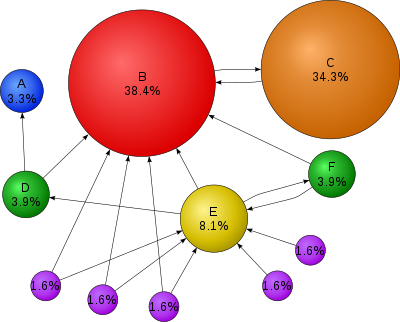Table of Contents¶
versioninfo()
Iterative Methods for Solving Linear Equations¶
Introduction¶
So far we have considered direct methods for solving linear equations.
- Direct methods (flops fixed a priori) vs iterative methods:
- Direct method (GE/LU, Cholesky, QR, SVD): good for dense, small to moderate sized $\mathbf{A}$
- Iterative methods (Jacobi, Gauss-Seidal, SOR, conjugate-gradient, GMRES): good for large, sparse, structured linear system, parallel computing, warm start
PageRank problem¶

$\mathbf{A} \in \{0,1\}^{n \times n}$ the connectivity matrix of webpages with entries $$ \begin{eqnarray*} a_{ij} = \begin{cases} 1 & \text{if page $i$ links to page $j$} \\ 0 & \text{otherwise} \end{cases}. \end{eqnarray*} $$ $n \approx 10^9$ in May 2017.
$r_i = \sum_j a_{ij}$ is the out-degree of page $i$.
Larry Page imagines a random surfer wandering on internet according to following rules:
- From a page $i$ with $r_i>0$
- with probability $p$, (s)he randomly chooses a link on page $i$ (uniformly) and follows that link to the next page
- with probability $1-p$, (s)he randomly chooses one page from the set of all $n$ pages (uniformly) and proceeds to that page
- From a page $i$ with $r_i=0$ (a dangling page), (s)he randomly chooses one page from the set of all $n$ pages (uniformly) and proceeds to that page
- From a page $i$ with $r_i>0$
The process defines a Markov chain on the space of $n$ pages. Stationary distribution of this Markov chain gives the ranks (probabilities) of each page.
Stationary distribution is the top left eigenvector of the transition matrix $\mathbf{P}$ corresponding to eigenvalue 1. Equivalently it can be cast as a linear equation. $$ (\mathbf{I} - \mathbf{P}^T) \mathbf{x} = \mathbf{0}. $$
Gene Golub: Largest matrix computation in world.
GE/LU will take $2 \times (10^9)^3/3/10^{12} \approx 6.66 \times 10^{14}$ seconds $\approx 20$ million years on a tera-flop supercomputer!
Iterative methods come to the rescue.
Jacobi method¶

Solve $\mathbf{A} \mathbf{x} = \mathbf{b}$.
Jacobi iteration: $$ x_i^{(t+1)} = \frac{b_i - \sum_{j=1}^{i-1} a_{ij} x_j^{(t)} - \sum_{j=i+1}^n a_{ij} x_j^{(t)}}{a_{ii}}. $$
With splitting: $\mathbf{A} = \mathbf{L} + \mathbf{D} + \mathbf{U}$, Jacobi iteration can be written as $$ \mathbf{D} \mathbf{x}^{(t+1)} = - (\mathbf{L} + \mathbf{U}) \mathbf{x}^{(t)} + \mathbf{b}, $$ i.e., $$ \mathbf{x}^{(t+1)} = - \mathbf{D}^{-1} (\mathbf{L} + \mathbf{U}) \mathbf{x}^{(t)} + \mathbf{D}^{-1} \mathbf{b} = - \mathbf{D}^{-1} \mathbf{A} \mathbf{x}^{(t)} + \mathbf{x}^{(t)} + \mathbf{D}^{-1} \mathbf{b}. $$
One round costs $2n^2$ flops with an unstructured $\mathbf{A}$. Gain over GE/LU if converges in $o(n)$ iterations. Saving is huge for sparse or structured $\mathbf{A}$. By structured, we mean the matrix-vector multiplication $\mathbf{A} \mathbf{v}$ is fast ($O(n)$ or $O(n \log n)$).
Gauss-Seidel method¶


Gauss-Seidel (GS) iteration: $$ x_i^{(t+1)} = \frac{b_i - \sum_{j=1}^{i-1} a_{ij} x_j^{(t+1)} - \sum_{j=i+1}^n a_{ij} x_j^{(t)}}{a_{ii}}. $$
With splitting, $(\mathbf{D} + \mathbf{L}) \mathbf{x}^{(t+1)} = - \mathbf{U} \mathbf{x}^{(t)} + \mathbf{b}$, i.e., $$ \mathbf{x}^{(t+1)} = - (\mathbf{D} + \mathbf{L})^{-1} \mathbf{U} \mathbf{x}^{(t)} + (\mathbf{D} + \mathbf{L})^{-1} \mathbf{b}. $$
GS converges for any $\mathbf{x}^{(0)}$ for symmetric and pd $\mathbf{A}$.
Convergence rate of Gauss-Seidel is the spectral radius of the $(\mathbf{D} + \mathbf{L})^{-1} \mathbf{U}$.
Successive over-relaxation (SOR)¶
SOR: $$ x_i^{(t+1)} = \omega \left( b_i - \sum_{j=1}^{i-1} a_{ij} x_j^{(t+1)} - \sum_{j=i+1}^n a_{ij} x_j^{(t)} \right) / a_{ii} + (1-\omega) x_i^{(t)}, $$ i.e., $$ \mathbf{x}^{(t+1)} = (\mathbf{D} + \omega \mathbf{L})^{-1} [(1-\omega) \mathbf{D} - \omega \mathbf{U}] \mathbf{x}^{(t)} + (\mathbf{D} + \omega \mathbf{L})^{-1} (\mathbf{D} + \mathbf{L})^{-1} \omega \mathbf{b}. $$
Need to pick $\omega \in [0,1]$ beforehand, with the goal of improving convergence rate.
Conjugate gradient method¶
Conjugate gradient and its variants are the top-notch iterative methods for solving huge, structured linear systems.
A UCLA invention! Hestenes and Steifel in 60s.
Solving $\mathbf{A} \mathbf{x} = \mathbf{b}$ is equivalent to minimizing the quadratic function $\frac{1}{2} \mathbf{x}^T \mathbf{A} \mathbf{x} - \mathbf{b}^T \mathbf{x}$.
Kershaw's results for a fusion problem.
| Method | Number of Iterations |
|---|---|
| Gauss Seidel | 208,000 |
| Block SOR methods | 765 |
| Incomplete Cholesky conjugate gradient | 25 |
MatrixDepot.jl¶
MatrixDepot.jl is an extensive collection of test matrices in Julia. After installation, we can check available test matrices by
using MatrixDepot
mdinfo()
# List matrices that are positive definite and sparse:
mdlist(:symmetric & :posdef & :sparse)
# Get help on Poisson matrix
mdinfo("poisson")
# Generate a Poisson matrix of dimension n=10
A = matrixdepot("poisson", 10)
using UnicodePlots
spy(A)
# Get help on Wathen matrix
mdinfo("wathen")
# Generate a Wathen matrix of dimension n=5
A = matrixdepot("wathen", 5)
spy(A)
Numerical examples¶
The IterativeSolvers.jl package implements most commonly used iterative solvers.
Generate test matrix¶
using BenchmarkTools, IterativeSolvers, LinearAlgebra, MatrixDepot, Random
Random.seed!(280)
n = 100
# Poisson matrix of dimension n^2=10000, pd and sparse
A = matrixdepot("poisson", n)
@show typeof(A)
# dense matrix representation of A
Afull = convert(Matrix, A)
@show typeof(Afull)
# sparsity level
count(!iszero, A) / length(A)
spy(A)
# storage difference
Base.summarysize(A), Base.summarysize(Afull)
Matrix-vector muliplication¶
# randomly generated vector of length n^2
b = randn(n^2)
# dense matrix-vector multiplication
@benchmark $Afull * $b
# sparse matrix-vector multiplication
@benchmark $A * $b
Dense solve via Cholesky¶
# record the Cholesky solution
xchol = cholesky(Afull) \ b;
# dense solve via Cholesky
@benchmark cholesky($Afull) \ $b
Jacobi solver¶
It seems that Jacobi solver doesn't give the correct answer.
xjacobi = jacobi(A, b)
@show norm(xjacobi - xchol)
Reading documentation we found that the default value of maxiter is 10. A couple trial runs shows that 30000 Jacobi iterations are enough to get an accurate solution.
xjacobi = jacobi(A, b, maxiter=30000)
@show norm(xjacobi - xchol)
@benchmark jacobi($A, $b, maxiter=30000)
Gauss-Seidal¶
# Gauss-Seidel solution is fairly close to Cholesky solution after 15000 iters
xgs = gauss_seidel(A, b, maxiter=15000)
@show norm(xgs - xchol)
@benchmark gauss_seidel($A, $b, maxiter=15000)
SOR¶
# symmetric SOR with ω=0.75
xsor = ssor(A, b, 0.75, maxiter=10000)
@show norm(xsor - xchol)
@benchmark sor($A, $b, 0.75, maxiter=10000)
Conjugate Gradient¶
# conjugate gradient
xcg = cg(A, b)
@show norm(xcg - xchol)
@benchmark cg($A, $b)